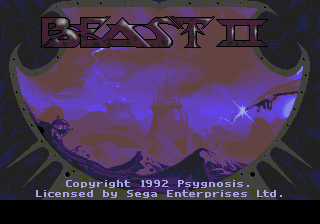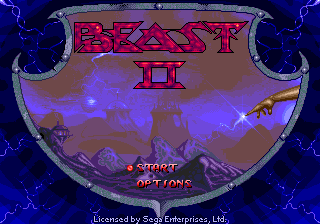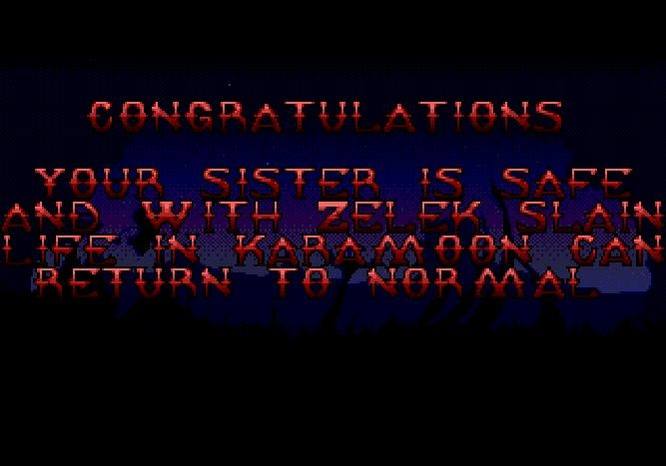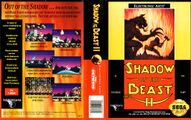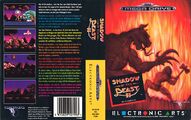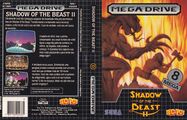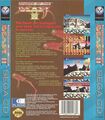Shadow of the Beast II
From Sega Retro
| ||||||||||||||||||||||||||||||||||||||||||||||||||
| Shadow of the Beast II | ||||||||||||||||||||||||||||||||||||||||||||||||||
|---|---|---|---|---|---|---|---|---|---|---|---|---|---|---|---|---|---|---|---|---|---|---|---|---|---|---|---|---|---|---|---|---|---|---|---|---|---|---|---|---|---|---|---|---|---|---|---|---|---|---|
| System(s): Sega Mega Drive, Sega Mega-CD | ||||||||||||||||||||||||||||||||||||||||||||||||||
| Publisher: Electronic Arts Psygnosis Victor Musical Industries (JP) | ||||||||||||||||||||||||||||||||||||||||||||||||||
| Developer: Reflections Interactive, Psygnosis WJS Design Digital Developments | ||||||||||||||||||||||||||||||||||||||||||||||||||
| Distributor: Hent Gruppen (SE rental) Tec Toy (BR) | ||||||||||||||||||||||||||||||||||||||||||||||||||
| Licensor: Psygnosis | ||||||||||||||||||||||||||||||||||||||||||||||||||
| Original system(s): Amiga | ||||||||||||||||||||||||||||||||||||||||||||||||||
| Developer(s) of original games: Reflections Interactive | ||||||||||||||||||||||||||||||||||||||||||||||||||
| Sound driver: Sound Images v1.2 RSS | ||||||||||||||||||||||||||||||||||||||||||||||||||
| Genre: Action[1][2] | ||||||||||||||||||||||||||||||||||||||||||||||||||
| Number of players: 1 | ||||||||||||||||||||||||||||||||||||||||||||||||||
| ||||||||||||||||||||||||||||||||||||||||||||||||||
|
Shadow of the Beast II, subtitled Shadow of the Beast II: Jyushin no Jubaku (シャドー・オブ・ザ・ビーストII 獣神の呪縛) in Japan, is a 1992 action game by Psygnosis, originally released for the Amiga before being ported to the Sega Mega Drive and Sega Mega-CD, and also the Atari ST and FM-Towns computers. It is the sequel to the original Shadow of the Beast and the second game in the Shadow of the Beast trilogy (the third game was an Amiga exclusive, though it was also going to be released for the Mega Drive).
Contents
Story
At the end of the first game, you manage to free yourself from a life of serving the Beast Lord, only to find your baby sister has been kidnapped by Zelek to take your place as a Beast Messenger. Infuriated, you set out to find your sister and destroy Zelek.
Gameplay
- Sega Mega Drive version:
The controls are simple: ![]() jumps,
jumps, ![]() fires,
fires, ![]() selects a weapon to fire. A flail replaces the punches from the first game. Items can be offered to certain characters by pausing the game, Gimmick sections from the first game have been removed.
The game is now even more open-worlded and non-linear. Due to this openness, limited hints and the failed puzzles not killing the player, it's possible to get stuck easily.
selects a weapon to fire. A flail replaces the punches from the first game. Items can be offered to certain characters by pausing the game, Gimmick sections from the first game have been removed.
The game is now even more open-worlded and non-linear. Due to this openness, limited hints and the failed puzzles not killing the player, it's possible to get stuck easily.
- Sega Mega-CD version:
TODO
Versions
- Around a quarter of the screen of the Sega Mega Drive is covered by a black bar that serves no purpose. Reasons for this are unknow, although it can be assumed this is due to the Sega Mega Drive version running at a higher resolution than the Amiga original and the developers not compensation this.
- The Sega Mega-CD and Sega Mega Drive version are largely different, with the Sega Mega-CD having more content, additional weapons, optimized graphics, slightly altered gameplay, cutscenes, extra dialogue options, more characters to interact with etc. It's generally considered to be the definite version of the game.
- Compared to the Amiga original, both versions feature a different player sprite, with the Sega Mega-CD's hero being slightly armored, and the Sega Mega Drive's hero only wearing pants.
- For the Sega Mega Drive version, cutscenes and background graphics were removed.
Localised names
| Language | Localised Name | English Translation |
|---|---|---|
| English | Shadow of the Beast II | Shadow of the Beast II |
| Japanese | シャドー・オブ・ザ・ビーストII 獣神の呪縛 | Shadow of the Beast II: Jyushin no Jubaku |
Production credits
Mega Drive version
- Original Game: Reflections
- MegaDrive Conversion: WJS Design
- Programming: Rob Povey
- Music and Sound Effects: Tony Williams
- Graphics: Lee Carus Westcott, Nicky Carus Westcott
- Bits N Pieces: Noel Hines
- Others Involved: Wayne Smithson, John White, Mike Simpson
- Thanks To: Leo Skirenko, Philip Watts
Mega-CD version
- Amiga Original: Reflections
- Sega Conversion By: Digital Developments
- Written By: Tim Swan, Andrew Bond
- Graphics: Andrew Bond, Lee Doyle
- FM Towns Graphics: Nicky and Lee Carus Westcott
- Sound Effects: Tim Swan, Kavin Collier
- Music: Derek Austin, Jimmy Jaketh
- Guitar: Ray Deefholts
- Music Produced By: Derek Austin, Bob Butterworth
- Recorded In: Roland RSS Stereo at Boxmead Studios UK
- Character Speech By: Tim Bentinck
- Quality Control: Pat Russell, Paul Euason, Graeme Love
- Story and Documentation: Nick Wild
- Project Management: John White, Mike Simpson, Tony Parkes, Steve Cain
- Copyright 1994 Psygnosis Ltd
- Japanese Translation: Yu Kakinomoto
- Producer: Kazuo Nakamura
Magazine articles
- Main article: Shadow of the Beast II/Magazine articles.
Promotional material
also published in:
- Game Players (US) #0612: "Vol. 6 No. 12 December 1993" (1993-1x-xx)[15]
- GamePro (US) #54: "January 1994" (199x-xx-xx)[16]
Artwork
Physical scans
Mega Drive version
| Sega Retro Average | |||||||||||||||||||||||||||||||||||||||||||||||||||||||||||||||||||||||||||||||||||||||||||||||||||||||||||||||||||||||||||||||||
|---|---|---|---|---|---|---|---|---|---|---|---|---|---|---|---|---|---|---|---|---|---|---|---|---|---|---|---|---|---|---|---|---|---|---|---|---|---|---|---|---|---|---|---|---|---|---|---|---|---|---|---|---|---|---|---|---|---|---|---|---|---|---|---|---|---|---|---|---|---|---|---|---|---|---|---|---|---|---|---|---|---|---|---|---|---|---|---|---|---|---|---|---|---|---|---|---|---|---|---|---|---|---|---|---|---|---|---|---|---|---|---|---|---|---|---|---|---|---|---|---|---|---|---|---|---|---|---|---|---|
|
| 68 | |
|---|---|
| Based on 25 reviews | |
| Mega Drive, SE (rental; Hent; black) |
|---|
| Mega Drive, SE rental (ALT - HENT orange?) |
|---|
|
Mega-CD version
| Sega Retro Average | |||||||||||||||||||||||||||||||||||||||||||||||||||||||||||||||||||||||||||||||||||||||||||||||||||
|---|---|---|---|---|---|---|---|---|---|---|---|---|---|---|---|---|---|---|---|---|---|---|---|---|---|---|---|---|---|---|---|---|---|---|---|---|---|---|---|---|---|---|---|---|---|---|---|---|---|---|---|---|---|---|---|---|---|---|---|---|---|---|---|---|---|---|---|---|---|---|---|---|---|---|---|---|---|---|---|---|---|---|---|---|---|---|---|---|---|---|---|---|---|---|---|---|---|---|---|
|
| 58 | |
|---|---|
| Based on 19 reviews | |
Technical information
- Main article: Shadow of the Beast II/Technical information.
References
- ↑ File:SotB2 MCD JP Box Back.jpg
- ↑ 2.0 2.1 https://sega.jp/fb/segahard/mcd/soft_licensee.html (Wayback Machine: 2019-06-10 17:56)
- ↑ Sega Visions, "November/December 1992" (US; 1992-xx-xx), page 93
- ↑ 4.0 4.1 GamePro, "March 1993" (US; 1993-xx-xx), page 48
- ↑ 5.0 5.1 Sega Mega Drive Advanced Gaming, "November 1992" (UK; 1992-xx-xx), page 11
- ↑ 6.0 6.1 6.2 Sega Zone, "November 1992" (UK; 1992-10-28), page 8
- ↑ 7.0 7.1 Computer & Video Games, "February 1993" (UK; 1993-01-15), page 76
- ↑ Beep! MegaDrive, "March 1994" (JP; 1994-02-08), page 9
- ↑ 9.0 9.1 Mega, "June 1994" (UK; 1994-05-19), page 39
- ↑ 10.0 10.1 Mega Power, "February 1994" (UK; 1994-01-20), page 28
- ↑ Computer Trade Weekly, "" (UK; 1994-07-25), page 17
- ↑ 12.0 12.1 Sega Magazine, "July 1994" (UK; 1994-06-16), page 78
- ↑ File:Shadow of the Beast II MCD credits.pdf
- ↑ File:Shadow of the Beast II MCD JP credits.pdf
- ↑ Game Players, "Vol. 6 No. 12 December 1993" (US; 1993-1x-xx), page 152
- ↑ GamePro, "January 1994" (US; 199x-xx-xx), page 188
- ↑ 1700 igr dlya Sega, "" (RU; 2001-xx-xx), page 203
- ↑ Consoles +, "Janvier 1993" (FR; 199x-xx-xx), page 74
- ↑ Mean Machines: The Essential Sega Guide, "" (UK; 1993-11-18), page 87
- ↑ Game Power, "Gennaio 1993" (IT; 199x-xx-xx), page 54
- ↑ Hobby Consolas, "Enero 1993" (ES; 199x-xx-xx), page 46
- ↑ Joypad, "Décembre 1992" (FR; 1992-1x-xx), page 98
- ↑ Joystick, "Janvier 1993" (FR; 199x-xx-xx), page 237
- ↑ Mega, "January 1993" (UK; 1992-12-17), page 56
- ↑ MegaTech, "January 1993" (UK; 1992-12-20), page 40
- ↑ Magazina Igrushek, "1/1996" (RU; 1996-xx-xx), page 64
- ↑ Mean Machines Sega, "January 1993" (UK; 1992-12-28), page 58
- ↑ Player One, "Janvier/Février 1993" (FR; 1993-01-10), page 94
- ↑ Play Time, "6/93" (DE; 1993-05-05), page 106
- ↑ Sega Power, "February 1993" (UK; 1993-01-07), page 50
- ↑ Sega Pro, "February 1993" (UK; 1993-01-14), page 53
- ↑ Sega Pro, "April 1993" (UK; 1993-03-11), page 67
- ↑ Sega Zone, "December 1992" (UK; 1992-11-xx), page 44
- ↑ Sega Force, "2/93" (SE; 1993-03-18), page 8
- ↑ Sega Force, "February 1993" (UK; 1993-01-14), page 78
- ↑ Sega Force, "June 1993" (UK; 1993-05-06), page 75
- ↑ Supersonic, "Janvier 1993" (FR; 199x-xx-xx), page 12
- ↑ Tricks 16 bit, "Tricks Sega Gold 800 igr" (RU; 1998-03-20), page 154
- ↑ Video Games, "2/93" (DE; 1993-01-27), page 88
- ↑ Beep! MegaDrive, "August 1994" (JP; 1994-07-08), page 22
- ↑ Consoles +, "Avril 1994" (FR; 1994-0x-xx), page 130
- ↑ Computer & Video Games, "August 1994" (UK; 1994-07-15), page 67
- ↑ Electronic Entertainment, "July 1995" (US; 1995-0x-xx), page 86
- ↑ Electronic Gaming Monthly, "February 1995" (US; 199x-xx-xx), page 34
- ↑ Famitsu, "1994-08-05" (JP; 1994-07-22), page 1
- ↑ Game Players, "Vol. 8 No. 3 March 1995" (US; 1995-0x-xx), page 56
- ↑ Joypad, "2/1994" (HU; 1994-xx-xx), page 12
- ↑ Mega Power, "May 1994" (UK; 1994-04-21), page 26
- ↑ MegaTech, "June 1994" (UK; 1994-05-19), page 62
- ↑ Next Generation, "April 1995" (US; 1995-03-21), page 96
- ↑ Player One, "Mars 1994" (FR; 1994-0x-xx), page 114
- ↑ Sega Magazine, "August 1994" (UK; 1994-07-15), page 96
- ↑ Sega Power, "June 1994" (UK; 1994-04-28), page 36
- ↑ Sega Pro, "May 1994" (UK; 1994-04-21), page 56
- ↑ Sega Zone, "May 1994" (UK; 1994-04-xx), page 48
- ↑ VideoGames, "February 1995" (US; 1995-0x-xx), page 80
| Shadow of the Beast II | |
|---|---|
|
Main page | Comparisons | Maps | Hidden content | Magazine articles | Video coverage | Reception | Region coding | Technical information
Demos: Beast II Demo Disc (1994) | |
- 1 player games
- US Mega Drive games
- All US games
- EU Mega Drive games
- All EU games
- UK Mega Drive games
- All UK games
- SE Mega Drive games
- All SE games
- BR Mega Drive games
- All BR games
- Mega Drive games
- 1992 Mega Drive games
- All 1992 games
- Mega Drive action games
- All action games
- JP Mega-CD games
- All JP games
- US Mega-CD games
- EU Mega-CD games
- UK Mega-CD games
- Mega-CD games
- 1994 Mega-CD games
- All 1994 games
- Mega-CD action games
- Mega-CD games with Roland Sound Space support
- All games
- Credits without source
- Credits without reference
- Old-style rating (mdag)
- Rating without PDF source
- Update ratings template
- 1 old ratings
- Shadow of the Beast II
